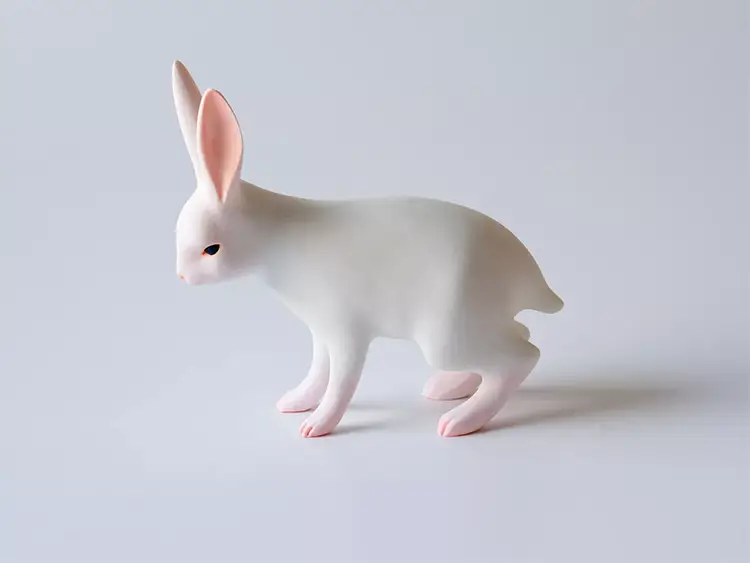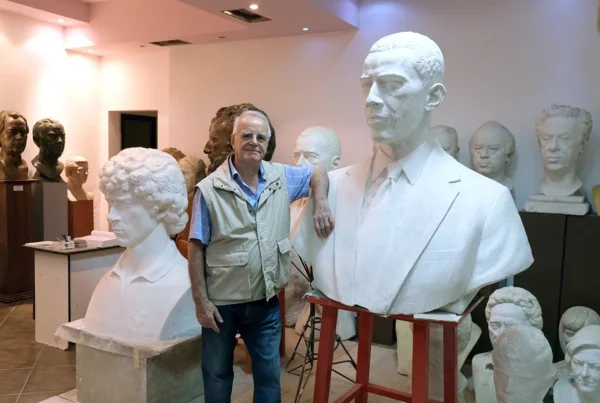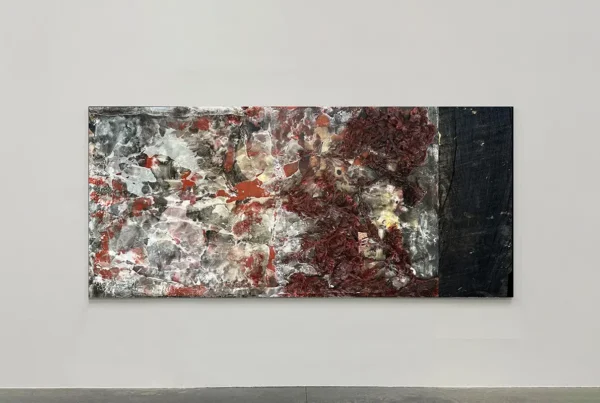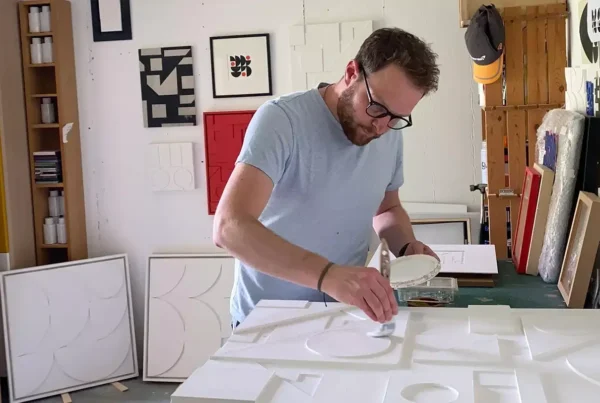Whispered Legends in Wood
Yoshimasa Tsuchiya’s art resides at the intersection of myth and memory, where the visible contours of wood give shape to the invisible stirrings of spirit and emotion. Best known for his lifelike wooden sculptures of animals and mythical beings, Tsuchiya transforms natural material into poetic representations of the intangible. His creatures — at once familiar and unfamiliar — reflect a personal mythology influenced by dreams, folklore, and traditional Japanese aesthetics. With eyes that seem to look beyond the present moment and forms suspended in quiet reverence, his sculptures evoke a stillness that asks viewers to pause, reflect, and reconsider their understanding of life’s unseen dimensions.
Born in 1977 in Yokosuka, Kanagawa, Tsuchiya pursued sculpture at Tokyo University of the Arts, where he later earned a PhD in Sculpture Conservation. His academic journey laid the foundation for his distinctive practice, deeply informed by his study of traditional Buddhist statuary. Techniques from this lineage — such as the insertion of crystal or glass eyes into hollowed-out heads — are integral to his approach. In Tsuchiya’s hands, these ancient methods are not preserved for nostalgia but reimagined for contemporary audiences. His use of light, pale colors, and smooth textures imparts an ethereal quality to his sculptures, giving them the appearance of beings not bound by gravity, as if they had just arrived from another world.
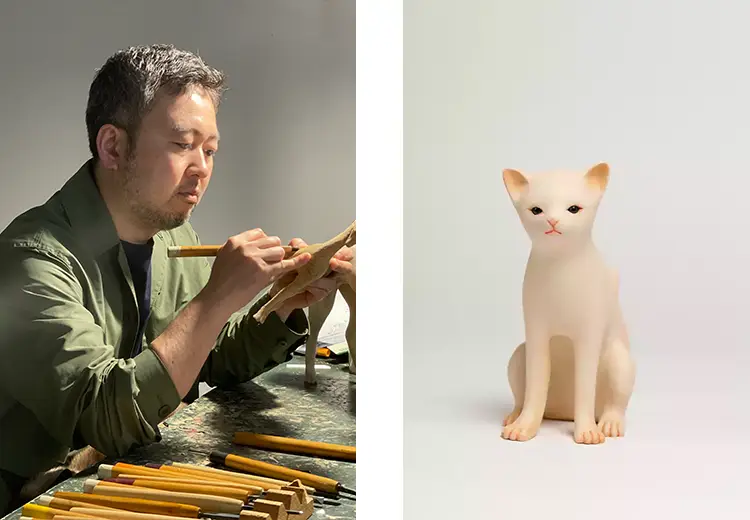
At the heart of Tsuchiya’s process lies a pursuit of emotional resonance. Each piece is a quiet narrative, shaped by the subtle tension between familiarity and estrangement. He frequently chooses animals as his motifs, not to replicate zoological forms, but to embody internal landscapes — memories, contradictions, transformations. From the ghostly softness of lambs to the haunting elegance of unicorns and phoenixes, his subjects function as vessels through which emotion and myth converge. Whether inspired by dreams or ancient stories, Tsuchiya’s creations encourage viewers to uncover the mythologies they carry within themselves.

Yoshimasa Tsuchiya: Between Myth and Mutation
Animals in Yoshimasa Tsuchiya’s work are not simply representations of the natural world; they are symbolic figures imbued with an emotional weight and spiritual ambiguity. By using animals that often appear in Japanese folklore — deer, lions, mermaids — he draws from shared cultural memory. Yet rather than replicating these forms as they are traditionally known, he distorts and reimagines them. A lion might lose its strength, a mythical beast may appear tender or shy. These quiet subversions challenge expectations and give the sculptures a sense of autonomy, as if they possess an identity separate from their creator’s intention. In doing so, Tsuchiya invites a dialogue between viewer and artwork, where ambiguity becomes an entry point for deeper reflection.
Central to his sculptural voice is his long-standing use of the Buddhist “gyokugan” technique. This ancient method of inserting glass or crystal eyes into carved figures imbues them with startling vitality. The effect is subtle but profound: his creatures do not merely appear to look outward; they seem to see inward. These glass eyes, custom-made by collaborator Fukuo Tanaka, provide a gaze that animates the stillness of wood, offering a glimpse into something sacred and unknowable. Tsuchiya does not plan facial expressions in detail before beginning a piece. Instead, expression and personality reveal themselves during the sculpting process, suggesting that his creations develop their own inner lives as they emerge from the block of wood.
Tsuchiya’s coloration technique further distinguishes his work. By layering pale whites with faint internal hues, he produces a milky translucency that recalls alabaster or baby skin — a surface both soft and ghostlike. He avoids decorative patterns or bold colors, believing that they distract from the essential spirit of the sculpture. The simplicity of his palette enhances the weightless sensation of his forms, contributing to their otherworldly quality. Whether depicting real animals or fantastical hybrids, Tsuchiya allows his creatures to hover between categories, never fully belonging to myth, nature, or dream — but drawing from all three.
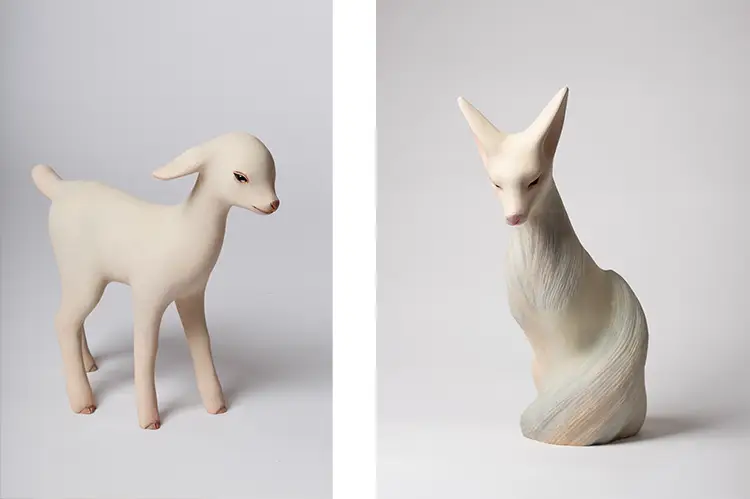
Sculpting Silence and Spirit
The stillness that characterizes Yoshimasa Tsuchiya’s sculptures is not empty; it brims with emotion, memory, and reverence. His artistic journey began in childhood, with an early dream of becoming a sculptor written in his kindergarten yearbook. Encouraged by a supportive family, he eventually encountered a turning point during an academic study trip. Confronted by the serene presence of the Eleven-Faced Kannon statue at the Dōganji Kannondō temple, Tsuchiya was profoundly moved. The sculpture’s flowing robes and graceful form seemed to stir the very air, offering a sacred presence that was more felt than seen. This moment reshaped his artistic ambitions, prompting him to seek a similar emotional depth in his own work.
From this inspiration grew a commitment to integrating traditional methods into contemporary forms. Tsuchiya primarily uses hinoki and camphor woods, which offer both durability and a luminous quality suitable for his aesthetic aims. Each sculpture begins with a template, followed by a rigorous sequence of sawing, carving, and smoothing. After the base form is complete, he applies layers of plaster and paint, culminating in a surface that feels soft yet ancient. By maintaining the natural warmth of wood while introducing elements of translucency and mystery, he succeeds in crafting objects that feel simultaneously familiar and surreal.
Nature also plays an unexpected role in shaping his sculptural language. Tsuchiya finds inspiration not only in animals but in the plants of his own garden. The curves and silhouettes of leaves, vines, and stems often inform the forms of his sculptures, merging botanical and zoological aesthetics. This connection to organic growth underlines his understanding of transformation as a central theme. His creatures, while grounded in myth and memory, seem to evolve like ornamental fish or cultivated plants — crossbred over time in the artist’s imagination. These influences, drawn from observation and introspection alike, contribute to a practice that emphasizes fluidity, ambiguity, and emotional resonance.
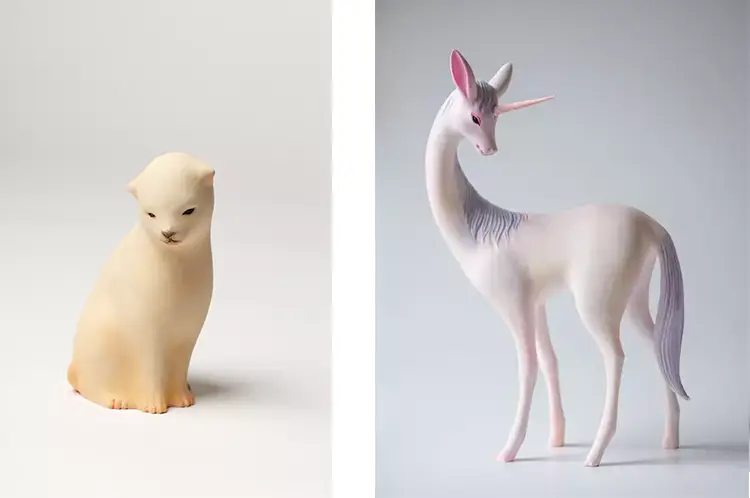
Yoshimasa Tsuchiya: Art Beyond the Pedestal
While Yoshimasa Tsuchiya’s sculptures often inhabit galleries and museums, he is equally committed to making art a part of everyday life. His desire to reach wider audiences led him to develop a line of “art toys” — miniature versions of his larger sculptures. These small-scale pieces maintain the signature features of his full-sized work, including the symbolic motifs, delicate coloration, and emotional expression. By offering these accessible works through an online shop, Tsuchiya allows more people to encounter and connect with his art, bringing the spiritual quietude of his sculptures into intimate, personal spaces.
His artistic aspirations continue to evolve, both in terms of medium and technique. Although wood remains his primary material, he has expressed an interest in exploring other substances to achieve new effects not possible with traditional carving. Likewise, his trademark pale palette may one day expand into a broader range of colors, reflecting his ongoing curiosity about how different treatments can alter the emotional tone of a piece. Tsuchiya’s openness to experimentation ensures that his work remains dynamic, resisting categorization even as it retains a strong and recognizable identity. His sculptures are not fixed points but living expressions, capable of growth and change just like the beings they represent.
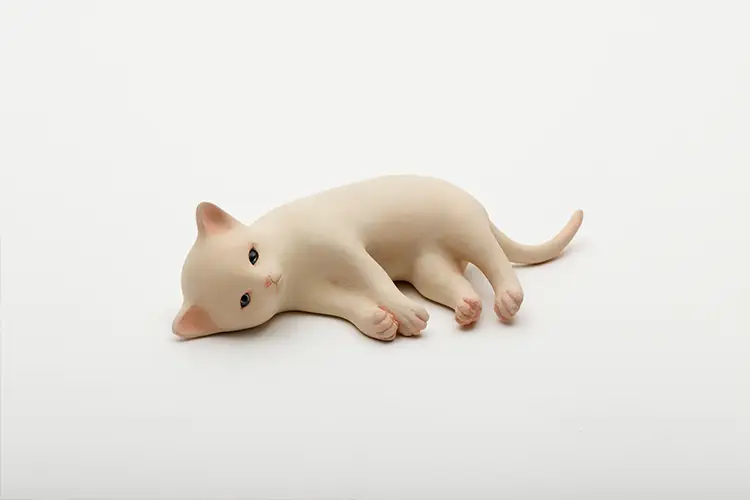
International recognition of his work continues to grow, with significant exhibitions and collectors across Asia, Europe, and North America. Notable solo shows include “Myth in the Forest” at Galerie Eigen + Art in Leipzig (2023), an exhibition at Kumanokodo Nakahechi Museum of Art (2021), and an earlier display at the Karuizawa New Art Museum (2013). Institutions such as the Arizona State University Art Museum and the Hokkaido Asahikawa Museum of Art have added his works to their collections, affirming his status as a significant voice in contemporary sculpture. Among his standout works is the camphor-wood piece Unicorn (2012), which fetched over $46,000 at auction, and the deer motif, which has been a consistent theme throughout his career and sold for a record-breaking sum at a 2022 Ravenel auction. These achievements reflect not just market success but the enduring resonance of Tsuchiya’s vision, one that continues to shape how we see, remember, and imagine.
Inquiries for Yoshimasa Tsuchiya:
MEGUMI OGITA GALLERY (Tokyo, Japan)
[email protected]
